Ophiopogon: types, planting and care
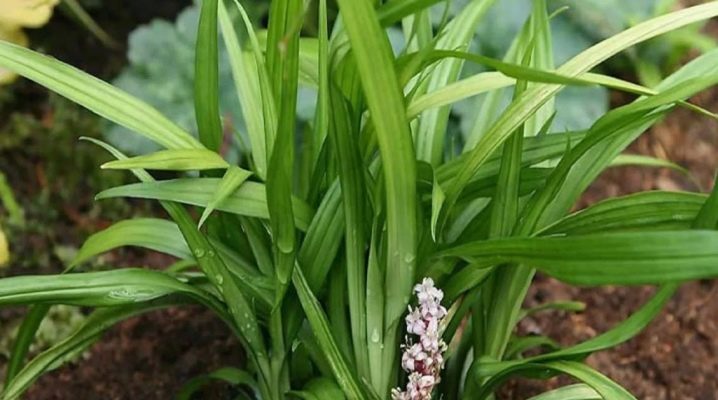
Florists and landscape designers recommend using a tropical plant such as ophiopogon to decorate living quarters and a personal plot. The flower has an unusual shape and color of the leaf plate, and also quickly adapts to any climatic conditions.
This plant can be used to create alpine slides, Japanese and Chinese-style flower beds, as well as decorating curbs and areas under trees. Green compositions will require a minimum amount of attention and physical effort, but they will delight their owners with the beauty throughout the year.
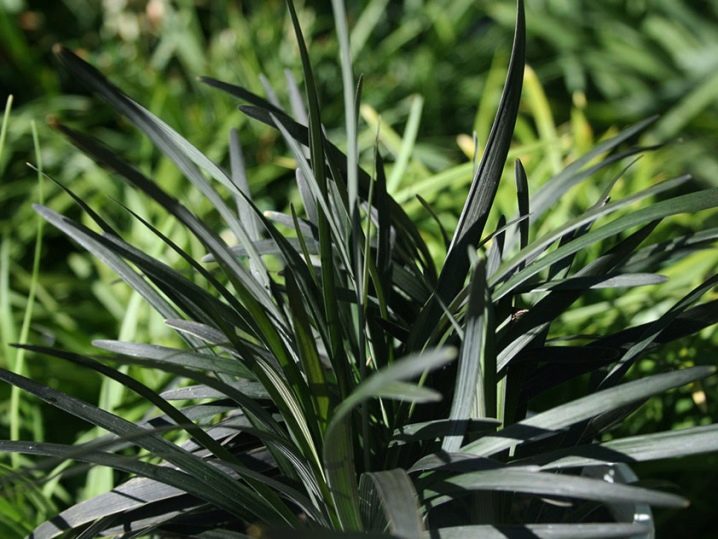
Description
Ophiopogon is a beautiful herbaceous plant that has a spreading and lush shape and belongs to the Liliaceae family. The homeland of this flower is the tropics of the Asia-Pacific region. Ophiopogon has not only botanical names, but also folk names - snakebeard, lily of the valley, japanese lily of the valley, dragon sting, monkey grass, snake beard... This unusual tropical plant can be grown both outdoors and in flower pots.
The root system is of a surface type and consists of small bulbs.
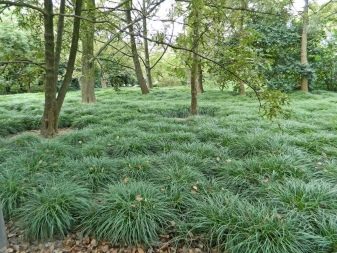
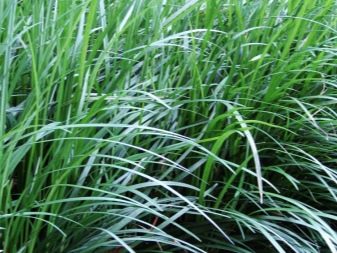
A distinctive feature of the flower is the presence of a large number of smooth, narrow and long leaf plates, which are formed from a central rosette. The shape of the leaves is linear with sharp ends. The color scheme of the leaves ranges from pale green to dark purple and depends on the variety. The maximum length of one leaf plate can reach 40 cm, and the standard width is 1 cm. The density and number of leaves remain unchanged throughout the growing period of the snakebeard.
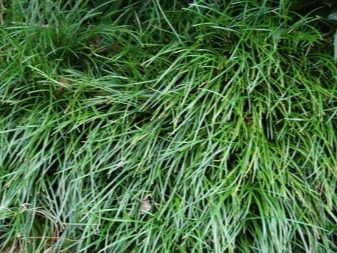
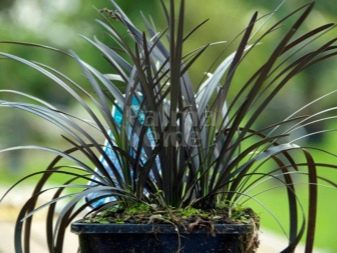
Lily of the valley bloom begins in mid-June and ends at the end of September. Spike-shaped inflorescences form on a long and fleshy peduncle, which is purple in color and a maximum length of 25 cm, and grows from the base of the bush. In one peduncle there are about 6 interconnected tubular flowers of purple color. After the withering of the inflorescences, dark blue fruits with round and yellow seeds are formed on the peduncle.
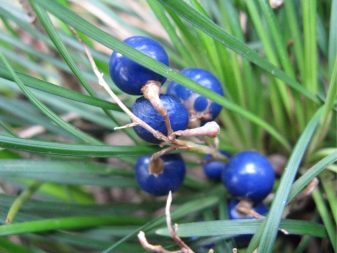
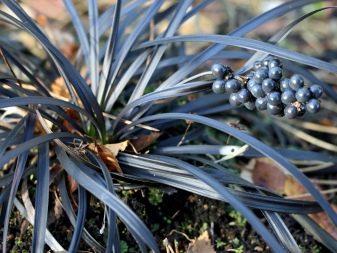
Designers use lily of the valley both to decorate living quarters and for zoning open recreation areas and flower beds and creating mixborders.
Ophiopogon is not only an ornamental plant, but also a medicinal plant. Preparations with flower roots have a positive effect on the central nervous system and increase immunity. The chemical composition of the juice consists of polysaccharides, carbohydrates, mucus, sitosterol, ruskogenin, isoflavonoids, vitamins A, B, C, D, calcium, copper, iron, zinc, chromium and sodium. The plant is used by oriental healers to treat the following ailments:
- upper respiratory tract diseases;
- inflammation of the gastrointestinal tract;
- tuberculosis;
- reduced immunity.


Like any folk remedy, drugs with ophiopogon have a number of contraindications:
- period of gestation and breastfeeding;
- children up to age 16;
- individual intolerance.

Before using the product, a consultation with a doctor is required.
Types and varieties
Biologists identify more than 20 species of this plant. For growing at home, breeders recommend using the following types.
- "Yaburan" - a perennial plant, the height of which can reach 80 cm. Straight leathery leaves with blunt ends are formed from the central rosette.The upper side of the leaf has a dark green tint, while on the lower one you can see pronounced veins. Inflorescences located on a straight peduncle can be painted both white and lilac. The most popular varieties of this type are:
- "Variegata" - a flower, along the edges of the leaf plate of which there is a white edging;
- "White Dragon" - a unique variety, the white leaf plate of which has a green vertical stripe in the center.
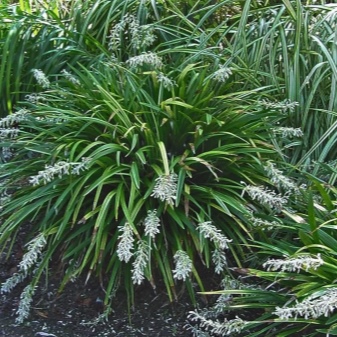

- Japanese - a popular species, the leaves of which have a slight bend towards the center. Numerous bulbs form at the ends of the fibrous root system. The length of the leaf plate does not exceed 35 cm, and the width is about 2.5 cm. Red-lilac inflorescences are formed on a short peduncle. Biologists recommend paying attention to the following varieties of this species:
- "Kuota Dwarf" - a small plant, the size of the leaf plate of which does not exceed 10 cm;
- Silver Dragon - a beautiful variety that has a white stripe in the center of a green leaf plate.
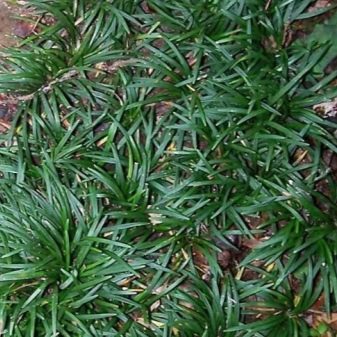
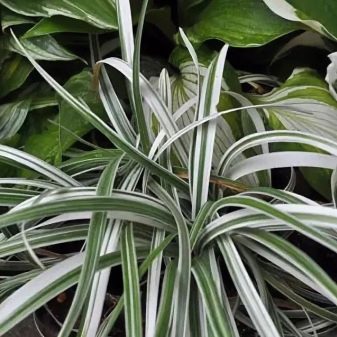
Biologists recommend paying attention to the dwarf varieties Compact, Kyoto dwarf, Nana, which are ground cover species and have a height of no more than 10 cm. The Silver fog and Minor varieties have a high level of decorativeness.
- Flat-fired - a low and spreading species that has a dark color of leaves. The maximum length of the leaf plate is 40 cm. The color of the inflorescences can be either white or pink. The most popular varieties are:
- "Black dragon" - a popular lush bush, the height of which does not exceed 30 cm. The color of the leaf plate and fruits is black, the plant easily tolerates a drop in temperature to -25 degrees;
- "Niger" - a low frost-resistant plant with black leaf plates, the color of the inflorescences is soft cream.
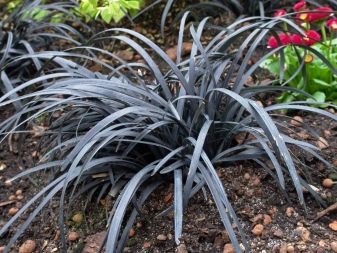
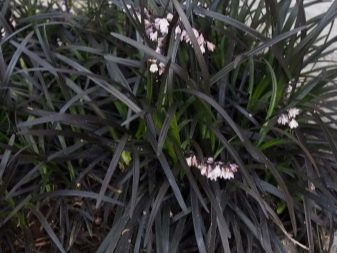
For growing in flower pots, florists recommend choosing indoor ophiopogon, which belongs to the thermophilic dwarf varieties. The plant has small forms and variegated leaf plates.
Landing
For planting this flower, you can use both purchased soil mixture and made yourself. To prepare a nutrient substrate at home, which should have a low level of acidity, it is necessary to mix in equal proportions leaf and sod soil with coarse sand and peat. To prevent decay of the root system, it is imperative to make a drainage layer, which may consist of pebbles or expanded clay.
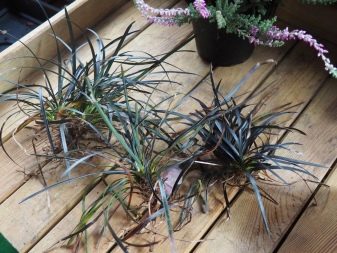
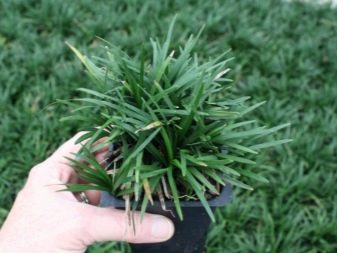
When transplanting, it is advisable to use the method of transferring an earthen coma along with intact roots, which will prevent mechanical damage to the root system. In order to plant a new plant, you can use the following propagation methods:
- Dividing the bush - the simplest and most popular breeding method, which is used even by novice growers. During the growing season, Japanese lily of the valley actively forms a large number of lateral shoots that can be used for planting. This procedure can be carried out in late spring or early summer. To obtain planting material, you need to remove the plant from the ground and divide it into several parts. Each part must have at least four outlets. A good planting option is to use a light and nutritious potting soil mixture, into which the plant should be deepened to the level of the root collar.
Regular and timely watering are the main factors that affect the survival rate of the shoots.
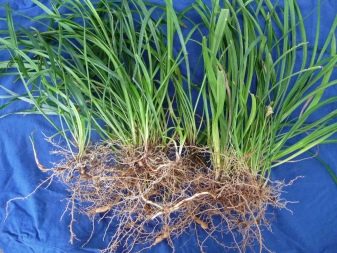

- Propagation using seeds - laborious and time consuming way. For planting the seed, experts recommend using a mixture of peat and sand. This process consists of the following activities:
- collecting seeds by extracting them from the fruit and separating them from the pulp;
- soaking the seed for at least 24 hours;
- placement of seed material on the surface of the soil (the maximum distance between seeds should be 4 cm);
- covering the landing containers with plastic wrap;
- placement of containers in a room with a temperature of no more than + 10 degrees.

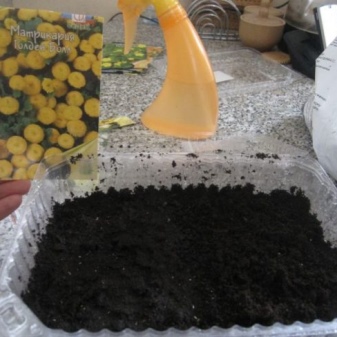
To prevent seed rot you need to regularly ventilate containers and do moderate watering. Only after the formation of several young leaves can a pick be carried out into small planting pots. Plants with a height of at least 10 cm can be planted in open ground.
When planting a Japanese lily of the valley in a flower bed, it is required to maintain a distance between the bushes of at least 25 cm.
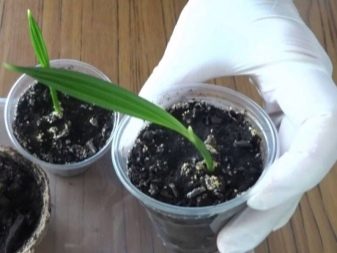
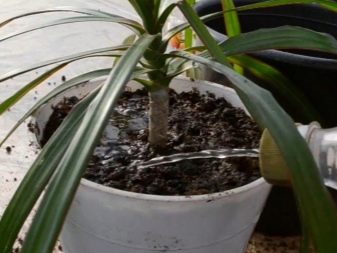
Care
Proper care is the key to getting a healthy and strong plant. Ophiopogon is an unpretentious plant that quickly adapts to different climatic conditions. The flower feels comfortable both in partial shade and in direct sunlight.
The optimum temperature for the growth and development of a flower is + 20 degrees. When placing flower pots on the window sills of windows that face the south or north side, it is impractical to install artificial light sources. From mid-spring, flower pots can be taken out to open-air loggias and balconies. The snakebeard is not afraid of sudden changes in temperature, strong winds and the scorching sun. In regions with a temperate climate, the flower thrives even under snow.
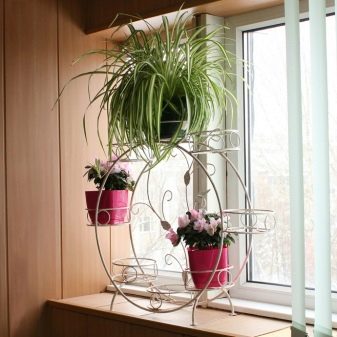

The serpentine prefers regular and abundant watering. Novice gardeners need to ensure that there is no waterlogging of the soil. In winter, it is worth moistening the soil only after the top nutrient layer has completely dried out.
For irrigation, it is better to use only settled water at room temperature, which contains a minimum amount of chlorine, lime and heavy metal salts.
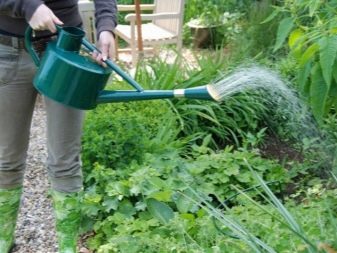
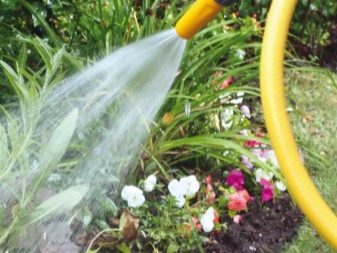
To prevent the leaves from drying out, you need to carry out regular spraying from a spray bottle... The plant feels comfortable near artificial reservoirs or aquariums, which significantly increase the level of moisture around it.
The plant needs additional nutrients. During the growing season, a complex of mineral fertilizers is applied several times, and at the end of autumn - organic fertilizing. In the autumn, it is imperative to carry out sanitary pruning of green mass. If the rules of care are not followed, the following problems may arise:
- yellowing of the leaf plate (excessive soil moisture);
- leaf fading (low light level);
- changes in the color of black leaves (exposure to low temperatures).
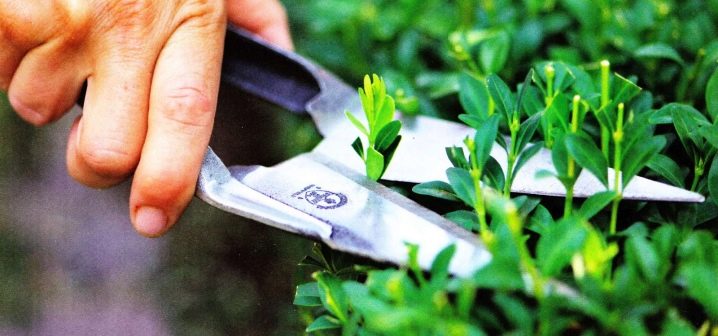
Particular attention should be paid to the Japanese snakehead, which is grown in aquariums. In these conditions, the flower can be grown for no more than 3 months. With a long stay of a flower in water, rotting of the root system may begin. The first signs of the development of putrefactive processes are the presence of an unpleasant odor and a change in the transparency of the water. Experts recommend growing the aquarium species in aquaterrariums when there are only roots in the water.
It is optimal to use a mixture of river sand, gravel, clay and peat as a nutrient soil. Under unusual conditions, the plant should receive the maximum amount of light for at least 10 hours.
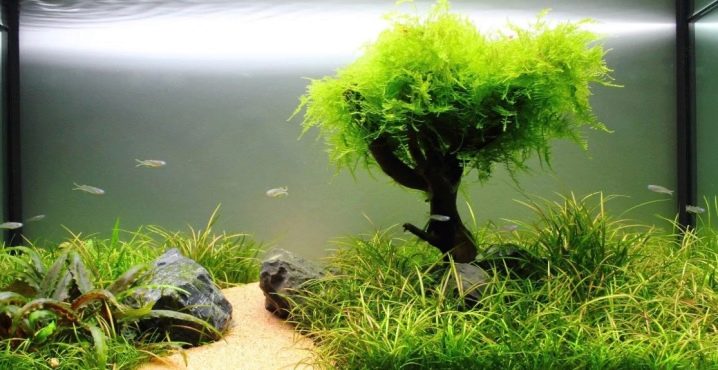
Diseases and pests
A tropical flower is not only an unpretentious plant, but also resistant to various diseases and some dangerous pests. Biologists identify several of the most dangerous types of pests.
- Slugs cause irreparable harm to young shoots. For their destruction, the use of special bait traps, collection of insects by hand is suitable.
- Thrips - dangerous insects that place their larvae inside the leaf plate. To destroy them, you will have to treat the plant with special chemicals.
- Whitefly - a winged pest, the larvae of which eat up the leaves and spoil their aesthetic appearance. To fight insects, you should use garlic tincture or chemicals.
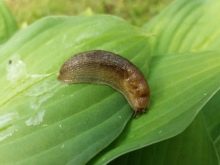

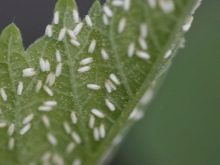
The plant has a strong immunity to fungal and viral diseases, but with abundant watering, root rot can develop
For information on how to properly care for ophiopogon, see the next video.























I was advised to plant ophiopogon in a flower bed. It turns out that it is one year old? We, in western Siberia, do not leave for the winter?
Ophiopogon is a perennial plant that lives in open ground, in Siberia it is possible under cover.
The comment was sent successfully.